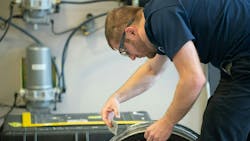Hiring best techs now requires social media, video savvy
In this article, you'll learn:
- How to leverage social media when hiring (and not only posting when there's an open position)
- How to build a library of videos and photos that attract technicians
While many aspects of hiring might feel like they're out of a shop or fleet's hands (whether a technician sees your job post among hundreds, whether they apply, how qualified they are), this doesn't mean that employers are powerless while on the hiring hunt. In fact, lots of the technology that's available today can help level the playing field in terms of exposure and candidate engagement, from social media to videos and photos.
Applying these resources strategically allows shops to make thier offer to the perfect candidate before they're snapped up by another shop.
Using social media
Making sure your shop has an engaging, informative job post and a clear careers page on its website is great, but these same principles need to be extended to your social media presence, too. Especially for younger technicians as they enter (or are preparing to enter) the job market.
“Technicians are going to go check you out,” warned Christopher Lawson, founder of Technician Find. “They’re going to check out your social media profiles. They’re going to look at your reviews.”
But this doesn’t need to be intimidating for shops. Lawson added that for social media, “It’s a lot cheaper to get eyeballs, so to speak, from a social media platform than it is to pay Indeed per application or with sponsorships.”
It helps to consider which social media platforms technicians are using, perhaps to find used tools or meet with their friends. And even more so, Lawson argued that shops shouldn’t just try to use social media to reach technicians, but their friends and family members.
“How do you get in front of a technician who may not be looking for work, but their spouse is tired of hearing them complain about the shop every night?” Lawson asked. “Social media is a great place to do that.”
Plus, social media gives shops an opportunity to show their culture and win technicians over that way. For example, Jacob Leach, a sr. mobile diesel technician with Fleet Services by Cox Automotive, explained that his team of mobile technicians gets together every quarter.
“Nine times out of 10, one of them gets posted on Facebook or any other social media,” Leach said. “I think that is awesome that they post that, because it gives the future applicants a chance to see that [we] may be mobile and scattered out, but [we] get together.’”
Media and technology
Finally, beyond the traditional ironing boards shops have to de-wrinkle their hiring process, plenty of technology is available as well. Joshua Taylor, host of the technician podcast Wrench Turners, is a big advocate for using video to help display a shop’s culture, making it a selling point for applicants.
“If you’re doing [something positive in the shop], you have a phone and a $25 tripod that goes up five feet,” he said. “Just record those once a day, every day, and pull something from that.”
These videos give shops something extra to post on social media, and topics can range from technicians discussing a job they’re working on, team-building outings, or a shop owner shouting out a tech or service advisor who’s done a good job.
“He is showing his staff that he appreciates them, and more importantly, he’s showing his guests that he appreciates his staff,” Taylor said. “That little tidbit can go a very long way, because we’re talking about exponential value here.”
As an example, TAT Express uses their YouTube channel to advertise positions and provide videos on diagnostics and maintenance tips.
Additionally, hiring and referral platforms can help shops be scientific about their hiring practices and adjust as needed. For instance, Lawson noted that shops can benefit from platforms that show how many people have seen their ads, how many have reached their application page, and how many people have applied. If the numbers are dropping off in a particular area, this could suggest that a shop’s compensation isn’t quite right or that the application is too dense.
For Jane Clark, SVP of operations at NationaLease, an applicant tracking system is invaluable.
“It helps you to manage your job applications, track your candidates, schedule interviews, and you can try to make the time to hire shorter,” she added.
Newer technologies, such as artificial intelligence, can assist shops in their hiring as well. Lawson said his business has tried a couple different forms of AI to troubleshoot his ads or to help generate talking points for shops before an interview. They’ve also used Google’s Notebook LM to generate podcast episodes on a shop’s business and used Perplexity AI to do “quick and dirty” salary surveys. But he did caution that AI (which he calls ‘AI Assisted’) is still a developing technology and should be double-checked. For example, Lawson’s team uses AI to augment their own research, processes, and frameworks to help their customers.
“You can use technology to go through applications, and sort and filter and that kind of thing,” Lawson said, “But one thing I’m always cautioning people is that you have to understand the limitations of the technology.”
Strike while the iron is hot
Having done all the legwork to create a strong job post, provide a careers page on their site, and curate a backlog of positive social buzz, let’s say a shop has met with a strong candidate. They’ve had a good interview, and the end of the hiring laundry cycle is in sight. All that’s left is to make the offer.
However, shops need to make that offer quickly, as due to the high demand for technicians, taking your time might stop you from hiring that qualified candidate at all.
“I always tell my clients that you may grab a technician before they’re actively looking, but once they make that decision in their mind that they’re looking, you have to assume they’re talking to at least two other shops,” Lawson warned.
But even once you’ve made the hire, the recruiting work doesn’t end, especially for shops that don’t want to repeat everything they’ve just done to make the hire. Instead, the focus goes to retention. That’s the phase where shops must back up all of those promises they made on their job post, website, and social media. If you don’t, that great tech you found and trained is likely to swap uniforms to a shop that will.
About the Author

Alex Keenan
Alex Keenan is an Associate Editor for Fleet Maintenance magazine. She has written on a variety of topics for the past several years and recently joined the transportation industry, reviewing content covering technician challenges and breaking industry news. She holds a bachelor's degree in English from Colorado State University in Fort Collins, Colorado.

